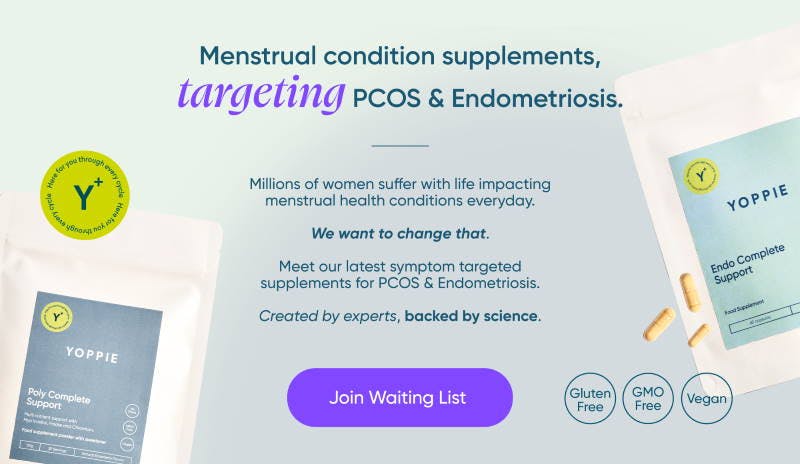This website uses cookies to enhance the user experience. By using Yoppie you are agreeing to our use of cookies.
Adenomyosis vs Endometriosis: Which Do You Have?
Written by Yoppie
11 Apr 2022
What is endometriosis?
OK, so what the heck is adenomyosis!?
What do adenomyosis and endometriosis have in common?
How are adenomyosis and endometriosis different?
How do I know if I have adenomyosis or endometriosis?
Is it possible to have both adenomyosis and endometriosis?
What are my risk factors for both conditions?
How do I make sure I get the right treatment?
Endometriosis is, thankfully, getting more airtime these days, with more people finally getting the diagnosis they should have had years earlier. Adenomyosis isn’t quite as well-known, and so the overlap in symptoms of these two conditions can sometimes cause confusion. Let’s compare the two and see what they have in common, how they’re different, how to tell which you have, and answer the question… could you have both?! Let’s see…
What is endometriosis?
If you’ve spent any time here on the Full Stop blog, you’ll probably know alllll about endo by now, but let’s do a quick recap: Endometriosis is a condition where tissue (similar to the tissue that lines the inside of the uterus) grows outside the uterus on the ovaries, fallopian tubes and/or inside the pelvis and more. This tissue reacts in the same way the tissue inside your uterus does each month; thickens during your cycle and breaks down. Unlike the kind that grows in the uterus, this tissue has nowhere to go and can cause mild to severe pain.
OK, so what the heck is adenomyosis!?
This one is a) a mouthful! And b) not as commonly known. Adenomyosis is a separate condition where the inner lining of the uterus breaks through the muscle wall of the uterus, either in just one spot or at various points. As you can imagine, this causes some issues! Symptoms include cramps, abdominal pressure, bloating, heavy periods, and more.
What do adenomyosis and endometriosis have in common?
Firstly, it’s important to note that neither of these conditions is life-threatening, although this doesn’t stop them being incredibly painful, irritating, and affecting daily life.
Some of the symptoms are pretty similar, with the main similarity being that both conditions tend to cause painful periods, known as dysmenorrhea. Other symptoms they have in common are pelvic pain, pain during sex, irregular or abnormal bleeding, and fertility issues.
How are adenomyosis and endometriosis different?
People often need to be checked by a doctor to know which one they have, as so many symptoms overlap with these two conditions. However, some notable endometriosis characteristics that could help you identify this one are painful bowel movements and/or urination, fatigue, and nausea and/or diarrhoea during your period. If you have these additional symptoms, then it’s possible you have endo rather than adenomyosis.
How do I know if I have adenomyosis or endometriosis?
It’s already notoriously difficult to diagnose endometriosis, meaning this overlap in symptoms could lead to the wrong diagnosis before the right one. When diagnosing endometriosis, your doctor will usually do a pelvic exam to feel for cysts, an ultrasound to see what’s going on inside, or a procedure called a laparoscopy, where a surgeon makes a few small incisions (under general anaesthesia) and inserts a tiny camera and instruments to look for signs of endo and, if found, remove it.
The path to diagnosing adenomyosis is pretty similar in the initial stages, starting with a pelvic exam. It’s thought to be difficult to diagnose adenomyosis without a hysterectomy, as an in-depth examination of the uterus is needed. Understandably, most people don’t want this, so often an ultrasound is done to rule out other causes. Since adenomyosis looks similar to uterine fibroids on ultrasound, an MRI or biopsy may be recommended instead.
Is it possible to have both adenomyosis and endometriosis?
These two conditions affect different parts of the uterus, and require different treatments, but it is thought that yes, you can have both of these conditions simultaneously. One 2017 study of 300 people diagnosed with adenomyosis found that 42.3% also had endometriosis.
What are my risk factors for both conditions?
Considering how similar the symptoms of these two conditions are, the risk factors are surprisingly different. Your chances of getting endometriosis increase if you:
- Are in your 30s or 40s
- Have a family history of endo
- Experience heavy periods that last over 7 days
- Have periods less than 27 days apart
- Started your period before age 11
Meanwhile, your chances of getting adenomyosis increase if you:
- Are in your 40s or older
- Have given birth before
- Started your period before age 10
- Have periods less than 24 days apart
How do I make sure I get the right treatment?
Both endo and adenomyosis don’t require treatment unless they’re causing problems in daily life, but if they are, speak to your doctor about treatment options. In some cases, both conditions can be managed with pain medications or hormonal medicines like birth control pills, and treatment for both can be anything from over-the-counter medications to surgery. You may be asked about medical history, desire for children, severity/frequency of pain, and recommended treatment based on age and personal circumstances.
In the case of endometriosis, a laparoscopy is often advised, while in suspected adenomyosis cases your doctor may recommend this, an endometrial ablation (where a laser destroys the lining of the uterus), or a number of other surgeries to fix the problem (or at least reduce symptoms).
Ultimately, your doctor can help you identify what you’re suffering from, whether that’s endo, adenomyosis, or something else. Recording your symptoms is usually the best place to begin, followed by a trip to your GP to start the conversation and try potential treatments.
Got a question about endometriosis or adenomyosis? Ask us over in our Full Stop FB group, or get in touch with us directly on Instagram at @itsyoppie and we’ll be happy to help! Don't forget that our personalised menstrual care subscription can get organic tampons, supplements for bloating, and much more, delivered easily and regularly through your letterbox, to help keep at least some of that uterus-related pain under control each month.
Section jump
Back to top
Subscribe To Our Newsletter
YOPPIE





© 2026 Yoppie is a registered trademark of Phlo Technologies Ltd.
Yoppie's supplements are not a substitute for a varied diet and healthy lifestyle and are not intended to diagnose, treat, or cure any disease. If you are pregnant, breastfeeding, have a medical condition or are under medical supervision, please consult with your doctor before taking any of our products.







